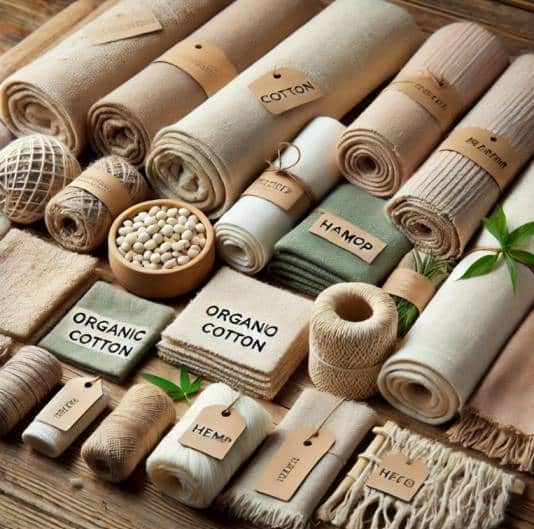What are Sustainable Fabrics?
Sustainable fabrics are eco-friendly textiles produced with minimal environmental impact. The products are created using renewable resources or recycled materials and are intended to minimize waste, preserve water, and decrease carbon emissions in manufacturing. Sustainable fabrics include natural fibers like organic cotton, hemp, and linen, as well as innovative materials such as Tencel (from wood pulp) and Piñatex (from pineapple leaves). These fabrics are often biodegradable, free from harmful chemicals, and ethically sourced, promoting fair labor practices. These textiles emphasize sustainability, reducing the environmental impact of the fashion and textile industries while supporting a more eco-friendly future.
Types of Sustainable Fabrics
- Organic Cotton: It is cultivated without the use of artificial pesticides or fertilizers, which supports soil health and helps decrease water usage. It is biodegradable and gentle on the skin.
- Linen: Made from flax plants, linen requires less water and pesticides compared to cotton. Its production process generates minimal waste, making it an eco-friendly choice.
- Hemp: Hemp growers recognize its resilience and minimal environmental footprint. They cultivate it rapidly without needing herbicides or pesticides. It also enriches the soil and absorbs carbon dioxide.
- Bamboo: Manufacturers create bamboo fabric from the pulp of rapidly growing bamboo grass, which they cultivate without using chemicals. It possesses natural antibacterial qualities and is capable of biodegrading.
- Recycled Polyester: Recycled polyester, created from post-consumer plastic bottles, contributes to reducing plastic waste. Its production uses less energy compared to virgin polyester and can be recycled multiple times.
- Recycled Cotton: Produced from textile waste, recycled cotton reduces the demand for new cotton and minimizes landfill contributions.
- Tencel (Lyocell): Created from sustainably sourced wood pulp, Tencel uses a closed-loop process that recycles water and solvents, minimizing environmental impact.
- Piñatex: A leather alternative made from pineapple leaf fibers, Piñatex provides a sustainable option for accessories and footwear while supporting local farmers.
How to Identify Sustainable Fabrics
- Check for Certifications: Look for reputable certifications like Global Organic Textile Standard (GOTS), OEKO-TEX Standard 100, and Fair Trade, which indicate compliance with sustainability and ethical practices.
- Read Labels: Examine product labels for material composition; natural or recycled fibers suggest sustainability. Avoid fabrics with high synthetic content.
- Research Brands: Investigate brands to understand their sustainability practices, sourcing methods, and commitment to eco-friendly production.
- Assess Fabric Lifecycle: Consider whether the fabric is biodegradable, recyclable, or made from renewable resources, which contributes to its overall sustainability.
- Inquire About Production: Ask about the manufacturing process, including water and energy use, chemical treatments, and labor practices to ensure ethical sourcing and production.
Benefits of Using Sustainable Fabrics
- Environmental Impact: Sustainable fabrics reduce resource consumption, such as water and energy, and lower carbon emissions during production, contributing to a healthier planet.
- Reduced Waste: By using recycled materials or biodegradable fibers, sustainable fabrics help minimize textile waste and encourage a circular economy.
- Health Benefits: Numerous eco-friendly textiles are devoid of harmful chemicals and toxins, which enhances consumer safety and is gentler on sensitive skin.
- Ethical Production: Sustainable fabrics often come from brands prioritizing fair labor practices, ensuring workers receive fair wages and safe working conditions.
- Durability: Sustainable fabrics, like hemp and organic cotton, are often more durable, resulting in longer-lasting products that reduce the need for frequent replacements.
Brands Leading the Way in Sustainable Fabrics
- Patagonia: Patagonia is renowned for its dedication to environmental sustainability, utilizing recycled materials in its products, and advocating for ethical labor standards throughout its supply chain.
- Eileen Fisher: This brand focuses on organic and renewable fibers, emphasizing transparency in sourcing and manufacturing while implementing a take-back program for used garments.
- Reformation: Reformation designs stylish clothing using eco-friendly materials, such as Tencel and recycled fabrics, and tracks its environmental impact through a transparency initiative.
- Outerknown: Co-founded by surfer Kelly Slater, Outerknown prioritizes sustainable materials and ethical production, including using organic cotton and recycled polyester.
- MUD Jeans: This Dutch brand creates denim from organic cotton and recycled materials, promoting a circular economy through its lease-a-jean program, encouraging consumers to return jeans for recycling.
Tips for Consumers
- Research Brands: Before making purchases, investigate brands’ sustainability practices. Look for transparency in sourcing and production methods and third-party certifications.
- Prioritize Quality: Select high-quality, durable fabrics that will endure over time, decreasing the need for frequent replacements and helping to minimize waste.
- Opt for Natural and Recycled Materials: Search for clothing made from organic cotton, hemp, Tencel, or recycled fibers, as these materials usually have a reduced environmental impact.
- Check Care Instructions: Follow proper care instructions to prolong the life of sustainable fabrics, reducing the frequency of replacements and the overall environmental footprint.
- Support Local and Ethical Brands: Purchase from local and ethical brands prioritizing fair labor practices and environmentally friendly production methods, contributing to a more sustainable economy.
- Buy Secondhand: Think about purchasing from thrift stores or online secondhand platforms to give clothing a new life and lessen the need for new production.
- Be Mindful of Trends: Choose timeless pieces over fast fashion trends, encouraging a more sustainable clothing consumption approach.
Conclusion
Embracing sustainable fabrics is essential for fostering a more eco-conscious fashion industry. Consumers can significantly reduce their environmental impact while supporting ethical production practices by opting for natural, recycled, and innovative textiles. Awareness of sustainable fabrics empowers individuals to make informed choices, prioritizing quality, durability, and responsible sourcing. As the demand for eco-friendly options grows, brands increasingly adopt sustainable practices, paving the way for a greener future. By choosing sustainable fabrics, consumers contribute to a circular economy, promoting sustainability and ensuring that future generations can enjoy a healthier planet.


